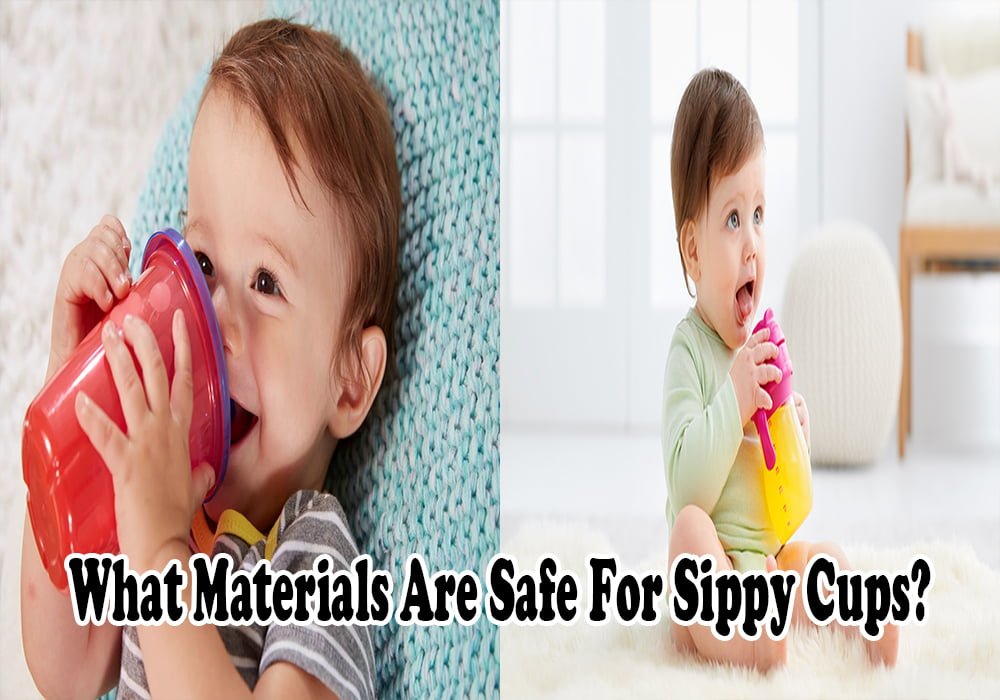Choosing the Right Sippy Cup
Choosing the right sippy cup is crucial. You need one that’s safe, durable, and easy to use. Knowing the best materials for sippy cups helps you pick the right one for your child.
Popular materials include plastic, stainless steel, silicone, glass, and wood. We’ll look at the pros and cons of each to help you decide.
We’ll also talk about how to pick a safe cup and how to clean and sanitize them. So, if you’re wondering about the best materials for sippy cups, keep reading!
Key Takeaways
- Stainless steel and silicone are safe for sippy cups as they’re non-toxic and don’t leach chemicals.
- Plastic cups might have BPA, which is risky for health.
- Glass cups are safe and recyclable but are heavy and can break easily.
- Wood cups are safe and eco-friendly, being durable and biodegradable.
Overview of Sippy Cup Materials
There are many materials for sippy cups, from plastic to stainless steel. Knowing the safety standards and BPA-free status is key when choosing.
Plastic is popular for being light and affordable. But, it might have BPA, which can leach into liquids. Look for ‘BPA-free’ or polypropylene plastic options.
Stainless steel cups are safer and more durable, without BPA or phthalates. They also keep drinks warm or cold longer.
Now, let’s compare these materials for usability…
Plastic
Plastic sippy cups are liked for being light, durable, and easy to clean. But, it’s vital to check plastic safety when picking sippy cups.
| Feature | Benefits/Risks |
| Plastic Safety | Not all plastics are safe; BPA-free options should be chosen. |
| Durability | Lightweight and durable; can sustain wear and tear over time. |
| Cleaning Ease | Easy to clean as they can often be hand washed or put in the dishwasher. |
Risks include toxins from recycled plastics that haven’t been tested. BPA-free options are safer and help reduce pollution. Now, let’s look at stainless steel sippy cups…
Stainless Steel
Stainless steel sippy cups are durable and last longer than plastic. They’re light, non-toxic, and safe. They resist corrosion and stay in good condition over time.
They also keep drinks at the right temperature. Cleaning them is easy with soap and water or the dishwasher.
Stainless steel is durable and safe compared to other materials. With care, they can last for many years. Now, let’s look at silicone sippy cups…
Silicone
Silicone sippy cups are becoming more popular. They offer many benefits for kids. They are durable and safe, making them stand out.
Silicone is tough and hard to break. It’s also safe for food and drinks. This makes it a great choice for sippy cups.
Unlike some plastics, silicone doesn’t leak chemicals. This makes it even safer for kids. It’s a durable and safe option for many families.
These cups are easy to use and maintain. They help families spend more time together. Switching to silicone sippy cups is a smart choice.
Glass
Glass sippy cups are a traditional and popular choice. They are durable and versatile.
Compared to plastic, glass is safer and more sustainable. It’s non-toxic and doesn’t leak chemicals. It’s also recyclable, unlike plastic.
But, glass sippy cups have downsides. They are heavier and can break easily. It’s important to weigh the pros and cons before choosing.
Next, we’ll look at wood as an alternative.
Wood
Wood sippy cups are eco-friendly and unique. They are made from renewable resources and are easy to care for. Here are some benefits:
- Natural, organic material
- Low maintenance
- Durable
- Biodegradable.
When choosing a wood sippy cup, consider its sustainability and care. Choose quality wood with safe finishes. This ensures it’s safe for your child.
With proper care, a wooden sippy cup can last for years. Now, let’s consider what to look for in a sippy cup.
Considerations for Choosing the Right Sippy Cup
Now you know about different sippy cup materials. It’s time to think about what to look for. The weaning process is key. Start by using a sippy cup in stages. Portion control helps too.
When picking a sippy cup, consider many factors. These include the material, size, and design. Think about what’s best for your child’s needs.
Considering these factors ensures your child enjoys their sippy cup. Now, let’s talk about what materials to avoid for a safe sippy cup.
What to Avoid
When picking a sippy cup for your child, know what to avoid. This ensures their safety and comfort.
- BPA (Bisphenol A) is harmful and should be avoided. Look for “BPA-free” or “non-toxic” labels. If not labeled, choose another option.
- Chemical leaching can happen with plastic sippy cups in extreme temperatures or sunlight.
- Lead poisoning is a risk with glass or ceramic sippy cups. Choose stainless steel or silicone instead.
To sum up, always check labels for BPA-, non-toxic-, and lead-free claims. This helps ensure your child’s sippy cup is safe. Now, let’s look at how to clean and sanitize it!
Tips for Cleaning and Sanitizing Sippy Cups
Cleaning and sanitizing your child’s sippy cup is key to their health. Let’s explore the best ways to do this!
Always wash the sippy cup with soap and water after each use. Make sure to clean all cracks and crevices. If no hot water is available, rinse well with cold water. Replace valves or parts every few months to prevent bacteria buildup.
For sanitizing, use only products made for children’s items. Soak parts in boiling water for 5 minutes, then let them cool before reassembling.
Don’t skip any steps when cleaning and sanitizing sippy cups. This keeps them safe from harm!
Frequently Asked Questions
Are sippy cups safe for toddlers?
Yes, sippy cups are safe for toddlers. They help in weaning from bottles. Just make sure they’re non-toxic and BPA-free.
What are the pros and cons of each sippy cup material?
There are many sippy cup materials to choose from. Consider their pros and cons before deciding.
Are sippy cups dishwasher safe?
It depends on the material. Plastic and stainless steel are usually dishwasher safe. Always follow the manufacturer’s cleaning instructions for the best results.
How much should I spend on a sippy cup?
Consider the design and material when buying a sippy cup. Look for BPA-free, dishwasher-safe options. Quality is important, so don’t go too cheap.
Are sippy cups BPA-free?
Yes, many sippy cups are BPA-free. Eco-friendly options like silicone and stainless steel are safe. Always look for “BPA-free” labels.
Conclusion
When choosing a sippy cup, consider the material. Safe options include plastic, stainless steel, silicone, glass, and wood. Avoid BPA or lead.
Regular cleaning and sanitizing are crucial for your child’s safety. Your child will have a safe drinking experience with the right choice and care.


